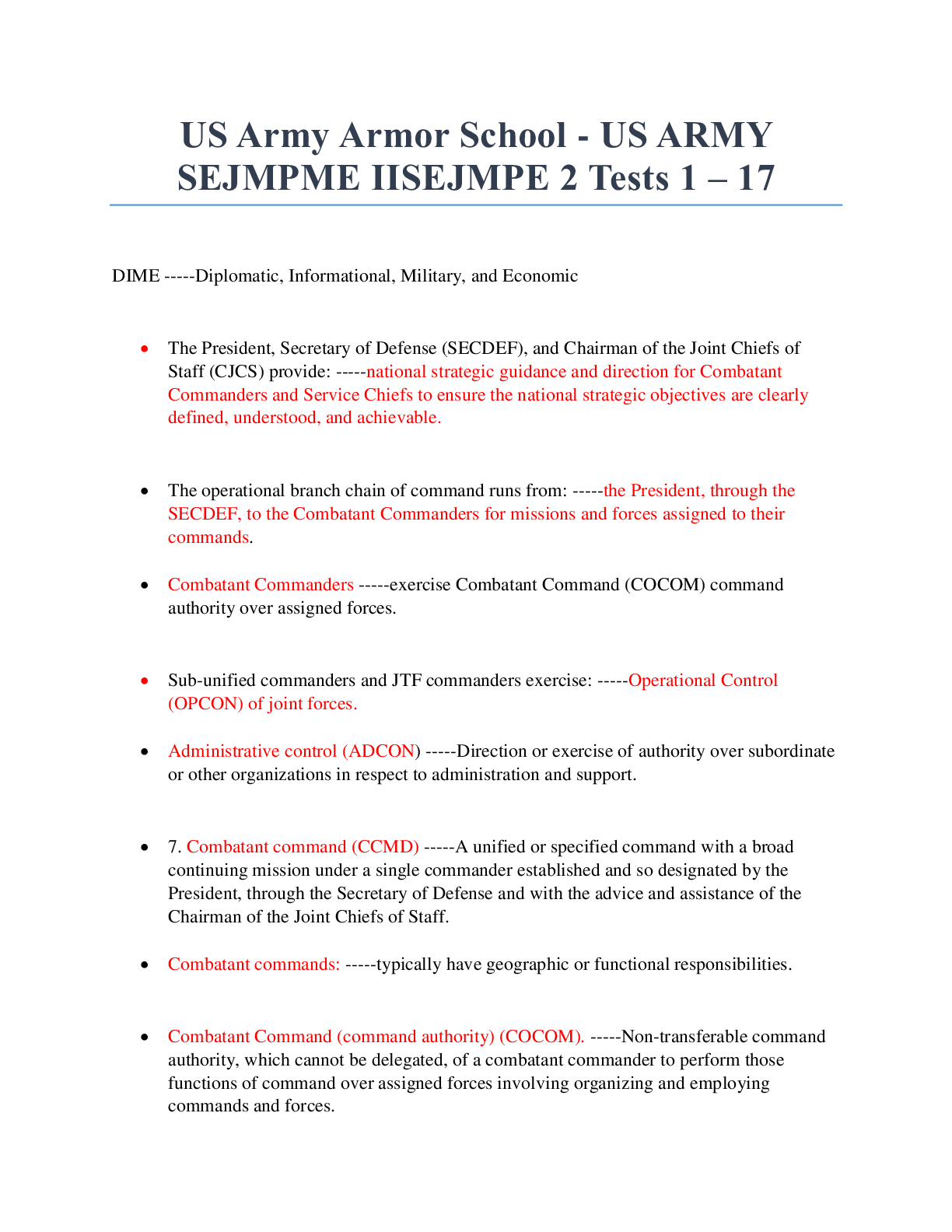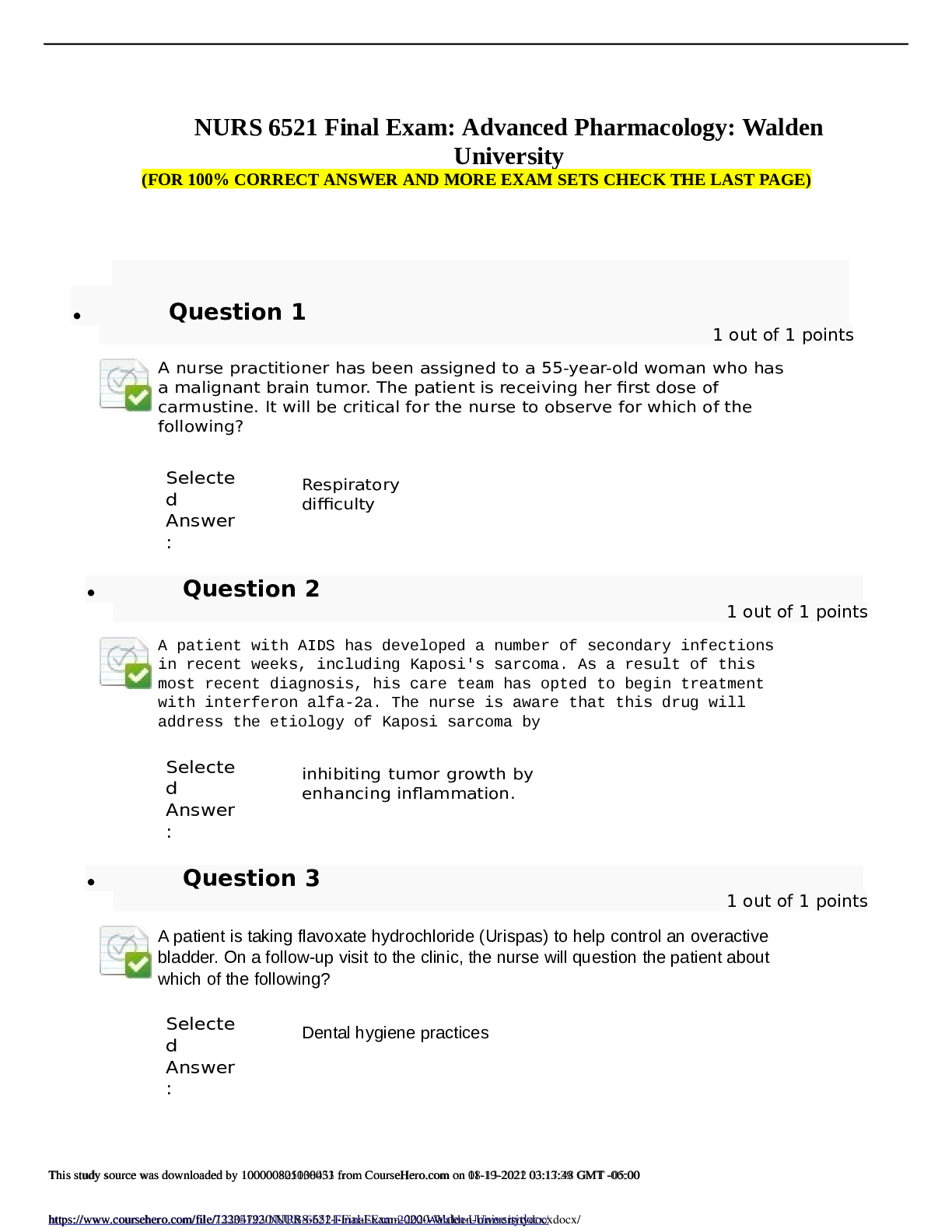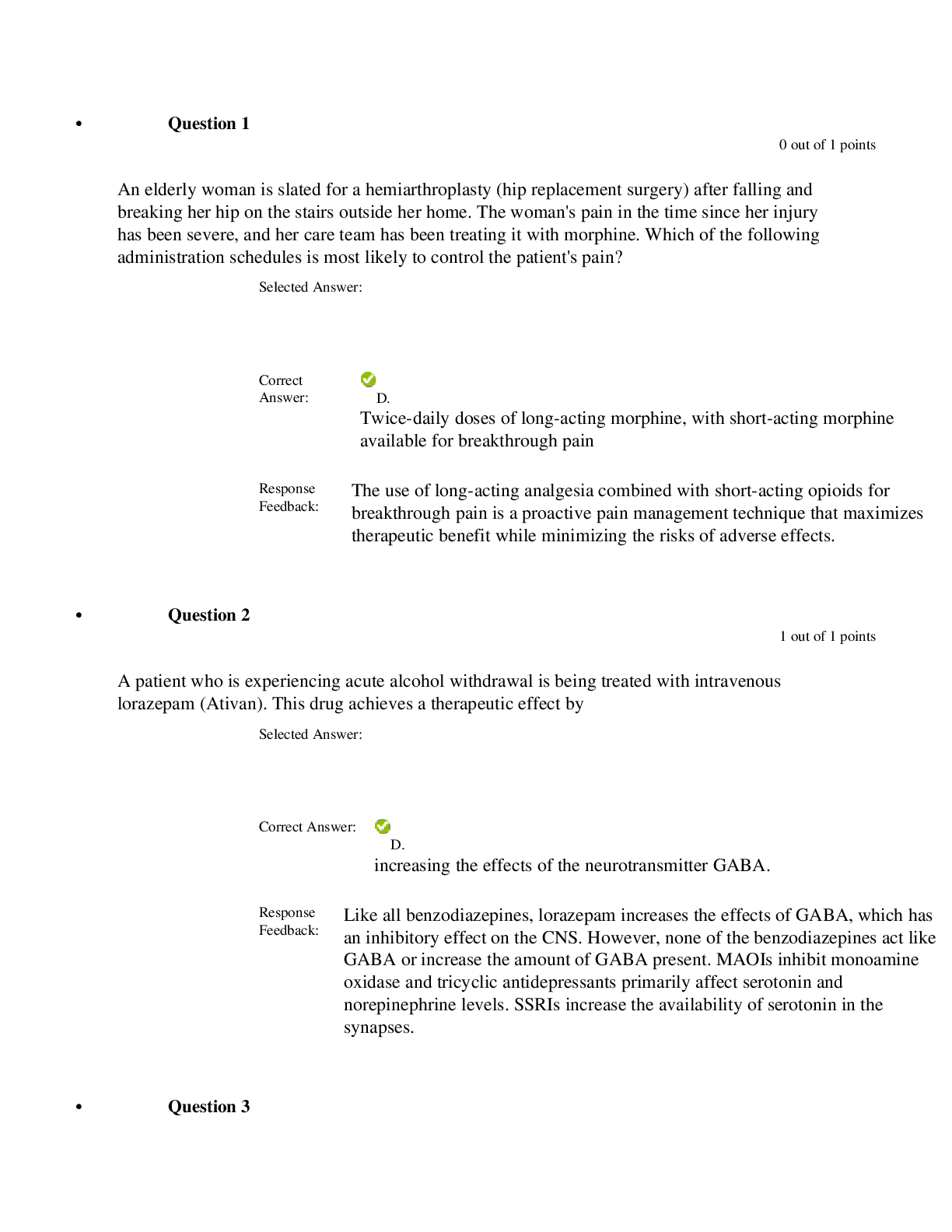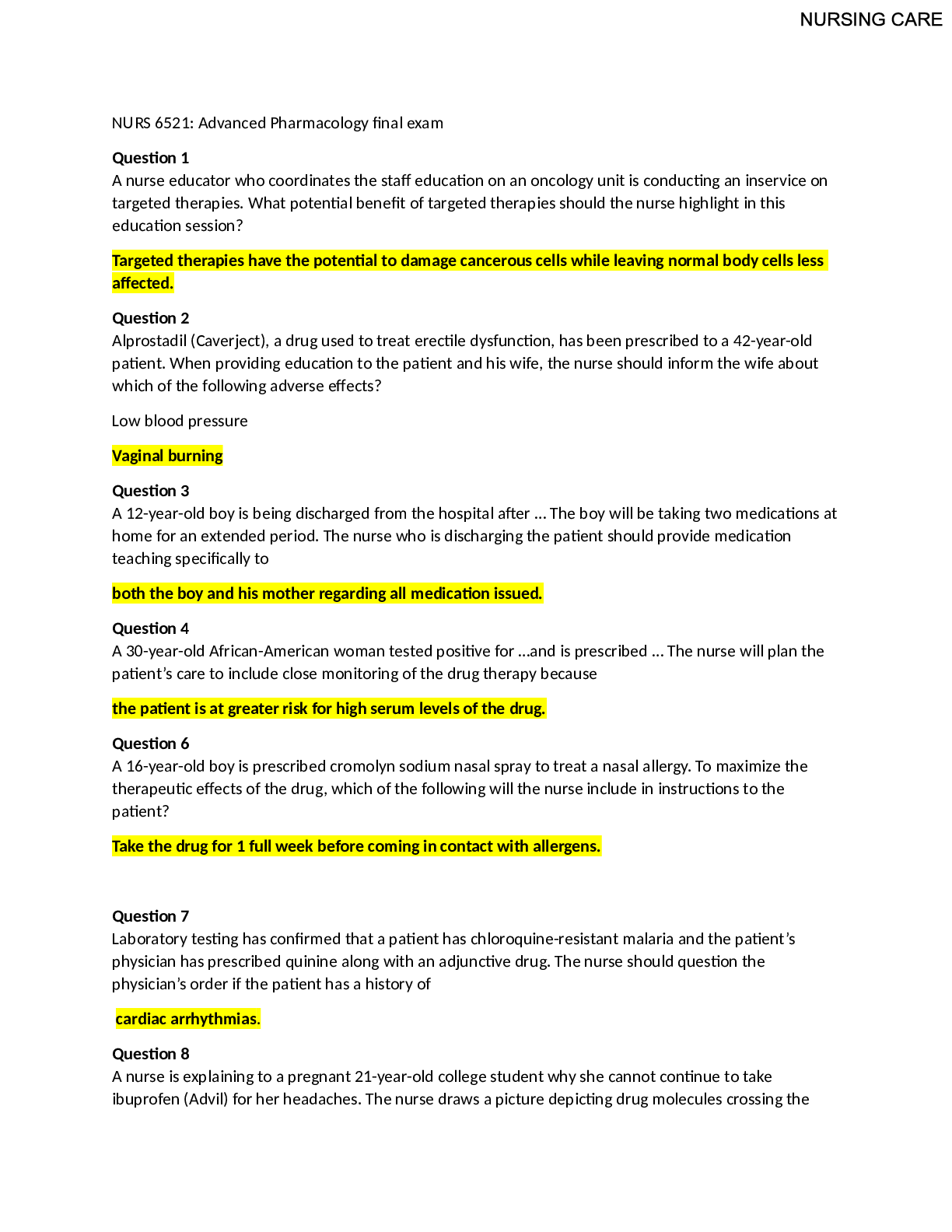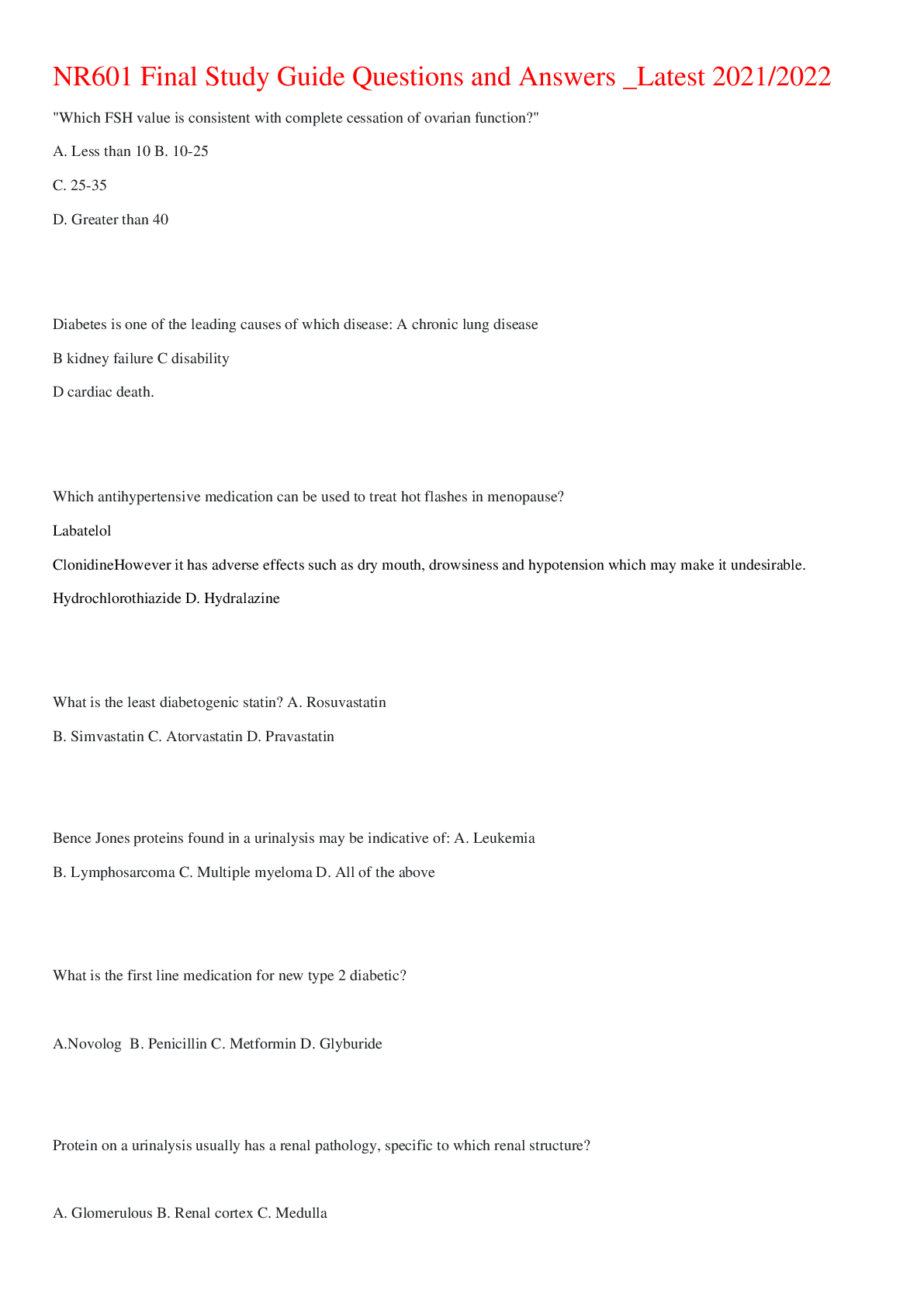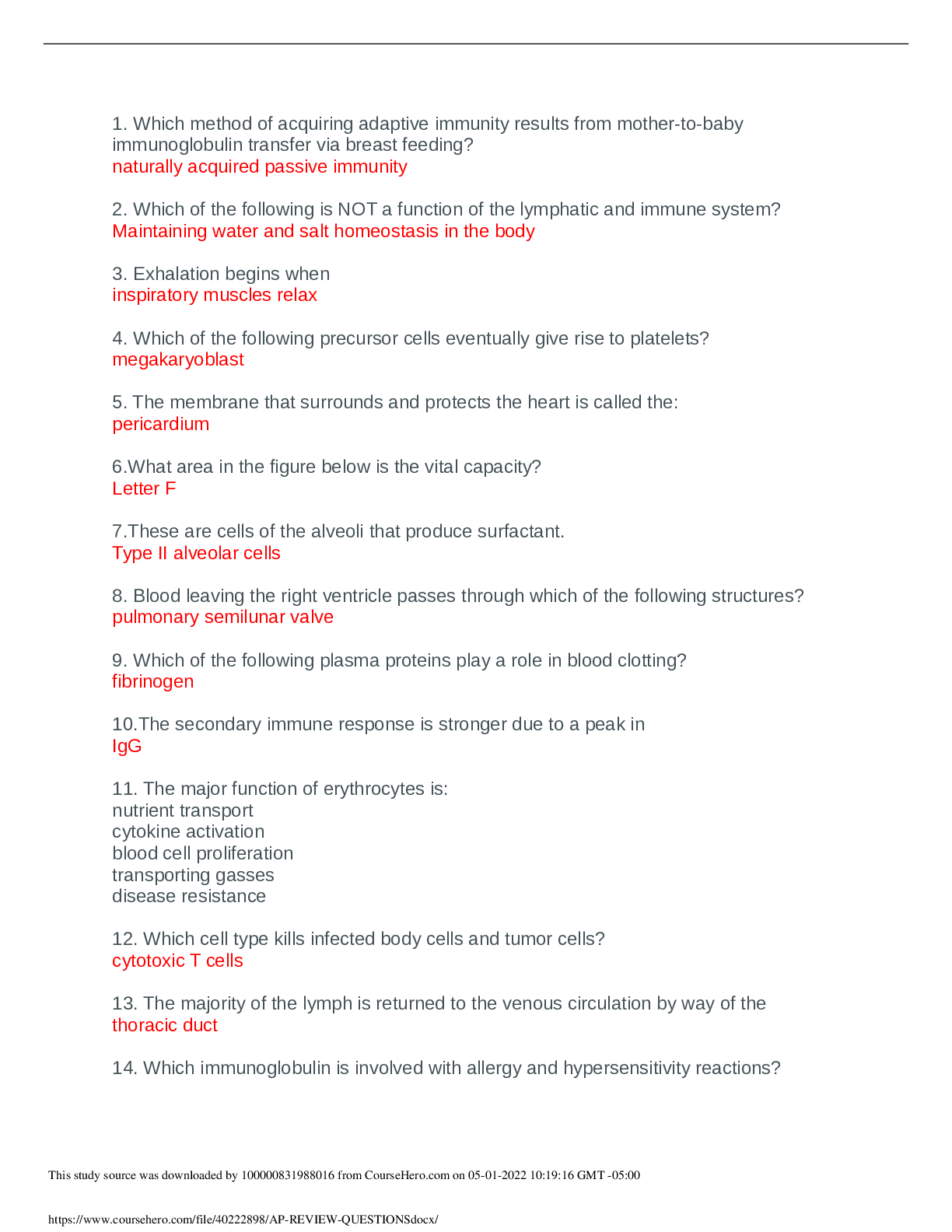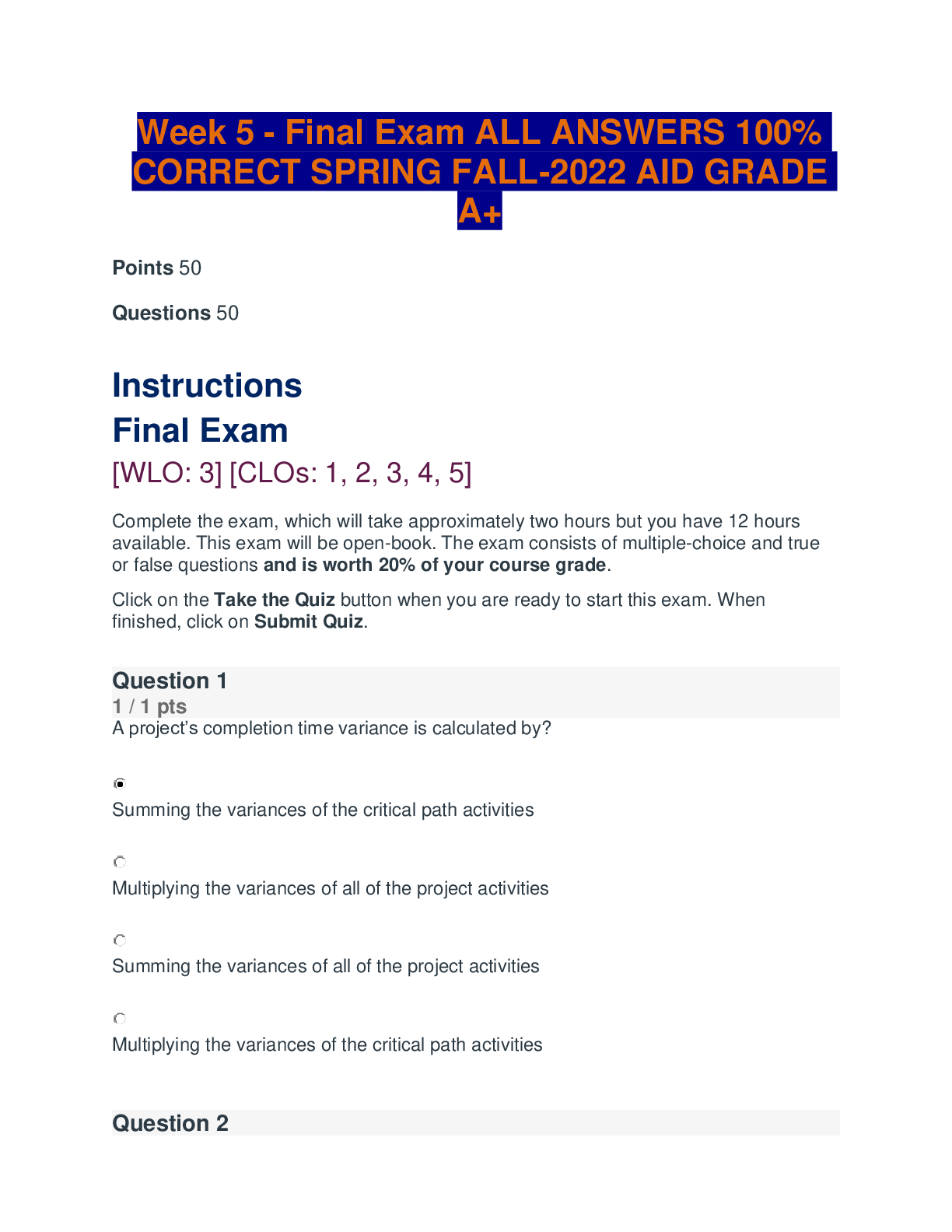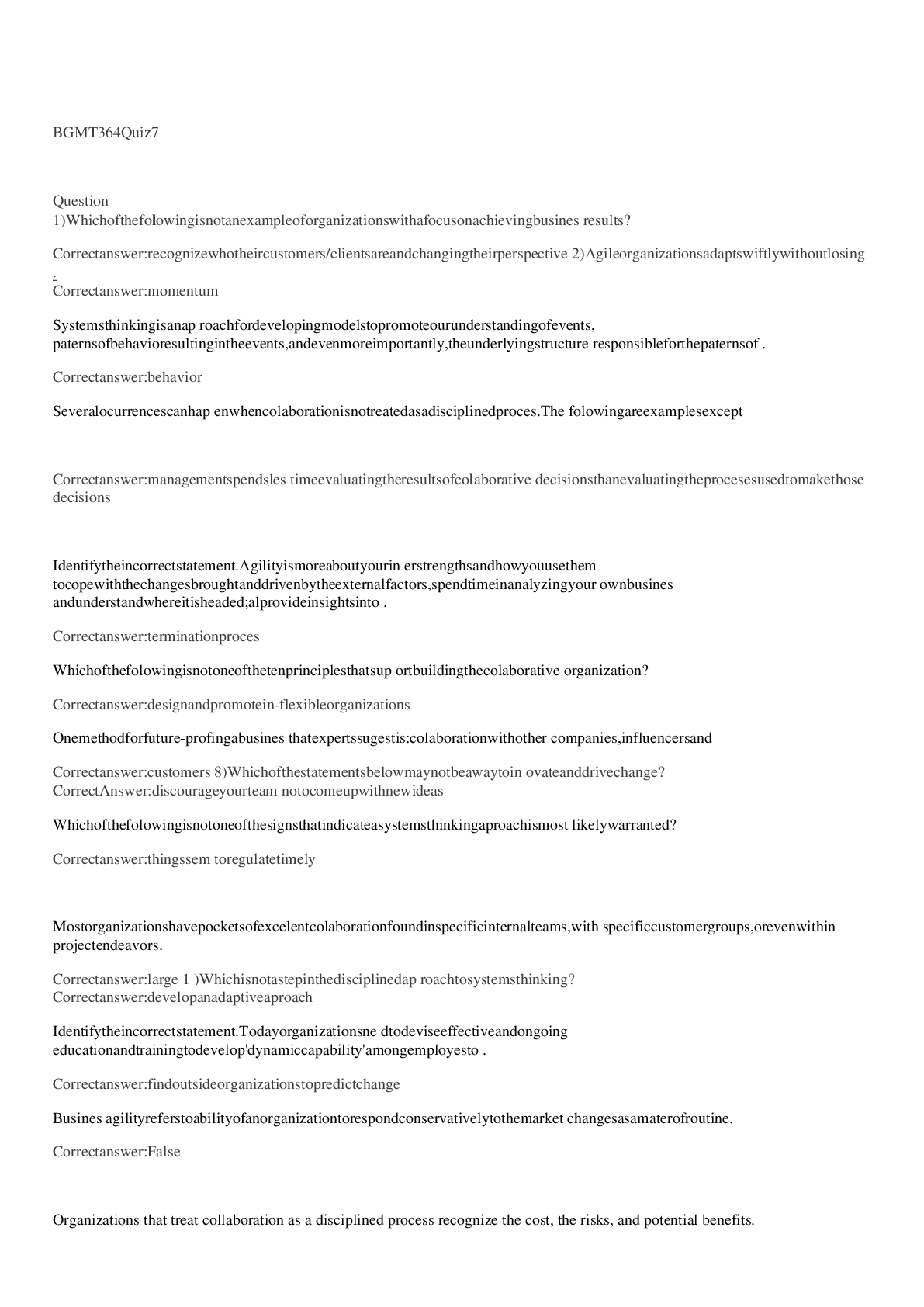Biology > QUESTIONS & ANSWERS > University of Maryland, University College BIOLOGY 101 Biology Final Exam 2020 March (All)
University of Maryland, University College BIOLOGY 101 Biology Final Exam 2020 March
Document Content and Description Below
BIOLOGY 101 OL1 Spring 2020 FINAL EXAMINATION _______________________________________________________________ Total possible points: 100 I. Multiple choice questions. Please bold or underline the ... correct answer (1point each=50 points) 1. What are monomer ‘building blocks’ that make up protein? A. monosaccharides B. glycerol molecules C. amino acids D. fatty acids E. cholesterol molecules 2. Suppose you conduct an experiment which simulates glacial recession over time. What is the dependent variable in this experiment? A. Glacial mass B. Sunlight C. The season D. Time 3. Which of the following terms includes all of the chemical reactions that occur within a cell? A. Cellular respiration B. catabolism C. redox reactions D. metabolism E. phosphorylation 4. The effectiveness of a medication containing growth hormones is tested on a group of young male rabbits 3 weeks of age. The best control group would be: A. Any group of rabbits B. A group of male rabbits, three weeks old, not given the medication C. A group of female rabbits, three weeks old, not given the medication 2 D. A mixed group of male/female rabbits, three weeks old, not given the medication E. No control is required; just measure whether the rabbits grew 5. What functions do enzymes perform? A. Increase substrate concentration B. Increase the temperature C. Increase the activation energy required for a reaction to occur. D. Decrease the activation energy required for a reaction to occur E. None of the above 6. Research the structure of starch. Based on your findings, amylase breaks down starch into what type of molecule? A. proteins B. sugars C. amino acids D. lipids E. nucleic acids 7. Where can ribosomes be located? A. nucleus B. cytoplasm C. Golgi body D. vesicles E. rough endoplasmic reticulum 8. One human disease is caused by a change in the DNA from GAA to GUA. This change is an example of: A. Crossing-over B. A meiosis error C. A mitosis error D. A mutation 9. During which part of the cell cycle is DNA polymerase most active? A. Cytokinesis B. G1 phase C. G2 phase D. S phase E. M phase 10. In what stage of the cell cycle are sister chromatids separated? A. interphase B. prophase C. metaphase D. anaphase E. telophase 3 11. Which term does not belong in this list? A. acid B. vinegar C. hydrogen ion donor D. pH 8 E. lactic acid 12. What is DNA made of? A. amino acids B. nucleotides C. amino acids and nucleotides D. sugar and phosphate E. bases and sugar 13. Each of the following is a true statement about photosynthesis, except A. The light reactions produce ATP from sunlight energy B. The products of photosynthesis are used as reactants in cellular respiration C. The products of cellular respiration are used as reactants in photosynthesis D. Water is used during photosynthesis to capture the electrons released from excited chlorophyll pigments E. The products of the light reactions of photosynthesis are used to produce sugars in the Calvin cycle 14. Suppose a female (chromosomes= ddBB) and a male (chromosomes= DDBb) of Species X mate. How likely is their offspring to exhibit the DdBb genotype? A. 0% B. 25% C. 50% D. 75% E. 100% 15. What term best describes the breeding performed in question 14? A. Codominance B. Dihybrid cross C. Incomplete dominance D. Monohybrid cross E. Crossing over 16. The polymerase chain reaction (PCR) is used to A. Analyze a person’s fingerprints B. Allow restriction enzymes to cut DNA at specific sequences C. Create recombinant DNA D. Make many copies of a small amount of DNA E. Cut DNA in to small pieces 17. Artificial selection includes which of the following? 4 A. breeding dogs for specific traits B. crossbreeding plants to produce cultivars C. selectively crossbreeding cats D. all of the above E. none of the above 18. Which of the following statements is false? A. Individuals with the same phenotype may have different genotypes B. Mating between individuals with dominant phenotypes cannot produce offspring with recessive phenotypes. C. Mating between individuals with recessive phenotypes cannot produce offspring with dominant phenotypes D. Individuals with the same genotype might have different phenotypes E. All of the above are correct 19. Which statement about the inheritance of blood types in humans is most likely to be correct? A. Types A and O are codominant to type B B. Types B and O are codominant to type A C. Types A and B are codominant to O D. Type O is dominant to both type A and type B E. Type A is dominant to B, O, and AB 20. Which of the following terms provides more specific information? A. Class B. Genus C. Domain D. Phylum E. Depends on the species 21. The principal structures in chloroplasts that play a role in photosynthesis are which of the following? A. grana B. lamella C. stroma D. thylakoids E. all of the above F. only C. and D. 22. How is energy typically stored in the food chain? A. Energy is stored in carbon-carbon bonds B. Energy is stored in hydrogen-hydrogen bonds C. Energy is stored in carbon-hydrogen bonds D. Energy is stored in oxygen-oxygen bonds E. Energy is stored in covalent bonds 5 23. In which of the phases of cellular respiration is the majority of ATP formed? A. Processing of pyruvic acid for the Krebs cycle B. Oxidative phosphorylation C. Glycolysis D. The Krebs cycle E. All phases produce the same number of ATP molecules 24. Meiosis results in A. 2 haploid daughter cells B. 2 diploid daughter cells C. 4 haploid daughter cells D. 6 haploid daughter cells 25. The starting materials of photosynthesis are _____________ A. Oxygen and glucose B. Carbon dioxide and oxygen C. Oxygen and water D. Carbon and oxygen E. Water and carbon dioxide 26. Which of these statements best explains how genes and proteins are related? A. Genes are building blocks of proteins B. Proteins are sections of DNA that code for genes C. Proteins are building blocks of genes D. Genes are segments of DNA that code for proteins E. Genes are segments of protein that code for DNA 27. In terms of natural selection, an organism’s fitness refers to its _________ A. Physical conditioning B. Size in relation to other members of the population C. Reproductive success D. Competitive ability E. Physical stature 28. The most important aspect of cellular respiration is that ___________________ A. It is the process that occurs only in animal cells B. It is the process that utilizes fat as its primary energy source C. It is the process that enables living organisms to utilize the energy stored in glucose D. It is the only cellular process that yields ATP 29. The statement best describes the relationship between plants and animals on earth is A. Plants produce O2 and sugars from CO2 B. Animals produce CO2 and H2O from sugars and O2 C. Plants produce O2 and sugars and animals produce CO2 and H2O D. Animals produce O2 and sugars and plants produce CO2 and H2O 6 30. During electron transport phosphorylation, which ions accumulate in the outer compartment of the mitochondria? A. calcium B. hydrogen C. oxygen D. phosphorus E. sodium 31. For Mendel’s explanation of inheritance to be correct, A. The genes for the traits he studied had to be located in the same chromosome B. Whichever gametes combine at fertilization had to be due to chance C. Genes could not be transmitted independently of each other D. Only diploid organisms would demonstrate inheritance patterns E. None of these 32. When celery is placed in a glass of pure water the solution inside its cells is _________ compared to the water. A. hypertonic B. hypotonic C. isotonic D. selectively permeable E. ready for diffusion 33. The number of _____________ in the outer shell of an atom determines the type of chemical bonds an atom can make. A. neutrons B. ions C. protons D. electrons E. neutrinos 34. Which of the following could not be a sequence of RNA? A. GCGUUU B. UAUGCG C. ATGCGT D. AUGCGU E. AAACUG 35. When comparing the DNA fingerprints of a parent to a child, the parent’s DNA must have A. All of the DNA bands that the child has B. Half of the DNA bands that a child has C. DNA bands that are very close to bands found in the child that are unique to her or him D. DNA bands that match closely those in the child’s DNA fingerprints and that are not from the other parent E. None of the above 7 36. In pea seed, yellow (Y) is dominant to green (y) and smooth (S) is dominant to wrinkled (s). What are the possible genotypes for the offspring of the following cross: YySS and YYSs. A. YYSS, YYss, yySS, yyss B. YS, yS, YS, yS C. Yy, SS, YY,Ss D. YYSS, YySS, YYSs, YySs 37. The benefits of wetlands include A. Protection of flooding B. Filtering of pollutants C. Increasing rate of water flow to bodies of water D. Both A. and B. E. Both B. and C. 38. During the last few years, scientists have observed that caribou have had a difficult annual migration due to the melting of _______________, creating impassable wetlands where there once was solid ground. A. Glaciers B. Snowfields C. Permafrost D. Icebergs E. Ice caps 39. A population pyramid A. Shows the age-specific distribution of females and males in a given country B. Shows exponential growth of a population C. Shows logistics growth of a population D. Indicates density-dependent regulation E. Shows regular population cycles 40. An ecologist is studying all the animals, plants, fungi, protists and bacteria, as well as the interactions among and between them in a forest. He is studying the ____________ in the forest. A. niche B. biome C. community D. population E. habitat 41. Microevolution is defined as: A. Changes in population size B. Changes in the frequency of alleles in the gene pool C. Changes in the composition of the population D. Emergence of new species E. Changes in community size 8 42. The ability of fireflies and angler fish to produce light is an example of convergent evolution. What can you conclude about these two animals based on this information? A. They share a recent common ancestor B. They are both adapted to environments low in light C. The ability to produce light is an ancient trait D. They are found in the same location E. All of the above 43. A recent study of ecological footprints concluded that A. Earth’s carrying capacity for humans is about 10 billion B. Earth’s carrying capacity would increase, if per capital meat consumption increased C. Current demand by industrialized countries for resources is much smaller than the ecological footprint of those countries D. It is not possible for technological improvements to increase Earth’s carrying capacity for humans E. The ecological footprint of USA is large because per capita resource use is high 44. Which of the following is support for the theory of evolution, which states that all life on Planet Earth arose from a common ancestor? A. All life on Earth shares a common organic chemistry B. All life on Earth has the same genetic material C. All life on Earth has the same basic cellular structures D. All life on Earth performs the same basic metabolic processes E. All of the above F. A, B, and C only 45. The majority of climate scientists suggest that the current change in climate is caused predominantly by ________. A. An enhancement of the greenhouse effect B. A decreased reliance on fossil fuels for energy C. A thinning of the ozone layer D. A melting of the polar ice caps E. An increase in solar radiation 46. Why is water so important in controlling the Earth’s climates? A. Water vapor is one of the greenhouse gases that help trap heat B. The water in oceans and lake stores the energy radiated by the Sun and releases it slowly C. Water may absorb and store a lot of energy by warming up by a few degrees only D. All of the above E. B. and C. only 47. If a wolf eats a rodent which ate a small insect which ate a plant, the wolf would be a(n) A. Autotroph B. Primary producer C. Primary consumer D. Secondary consumer 9 E. Tertiary consumer 48. Which of the following is not capable of evolving? A. A population of fruit flies B. A population of asexually reproducing fruitflies C. A rose bush D. The collective feral cats of a city E. All the HIV in a single patient 49. The best strategy for preserving biodiversity is to A. Depend on the Endangered Species Act to have its intended consequences B. Prevent inbreeding in small populations C. Use genetic engineering to create new combinations of genes D. Prevent species from becoming endangered in the first place E. Increase the numbers of zoos worldwide 50. If you were to buy land to plant crops, which type of biome would your prefer? A. Savannah B. Prairie C. Tropical forest D. Chaparral E. Temperate forest II. Matching of definitions and terms. Please place the correct number in front of each definition. (1 point each = 10 points): __3__ Characteristic of water which protects fish in a frozen lake __15__ Carbon makes a good backbone for creating diverse molecules. __20__ Structures found together in eukaryotic cells _13___ It is a ‘metabolic taxicab’ which shuttles electrons. _18___ Chlorophyll pigments in green leaves absorb certain colors of the visible light waves. _10___ Protein synthesis follows a specific sequence of events. _7___ Both codons CCC and CCU code for proline. _19___ Corals harbor special guests in their bodies to feed them. ___5_ Some time go, grazing livestock were introduced to the Savanna in Africa. __17__ In some areas, Conifer trees are very abundant. 1. cytoplasm and plasma membrane 2. RNADNAprotein 3. cohesion 4. blue and red 5. increased food production in times of famine 6. temperate forests 7. redundancy of the genetic code 8. is good at forming ionic bonds 9. bacteria 10. DNARNAprotein 10 11. decreased density at low temperature 12. desertification 13. NADH 14. universality of the genetic code 15. forms for covalent bonds 16. ATP 17. boreal forests 18. green and blue 19. photosynthetic algae 20. ribosomes and endoplasmic reticulum III. True-False questions. (1 point each = 5 points): 1. Any individual organism has the potential to adapt to its environment, if it is given enough time and possesses a mechanism to generate variation. A. True B. False 2. Mitochondria and chloroplasts, organelles in eukaryotic cells, are very similar to prokaryotes. A. True B. False 3. During a time, when resources are abundant, one would not expect much evolutionary change to happen. A. True B. False 4. In general, the more narrow a species’ habitat tolerance, the larger the range of the species. A. True B. False 5. When a founder population has a small gene pool, evolutionary change is more likely to be rapid than if the founder population has a large gene pool. A. True B. False IV. Fill-in statements. (1/2 point each=5 points) 1. Scientific information called ___data_______ collected from well-designed experiments should allow researchers to either accept or reject a null-hypothesis. 2. During glycolysis, a glucose molecule is broken into two molecules of _____pyruvate___ __. 11 3. In plant leaves, carbon dioxide enters and oxygen exists via tiny pores called ____stroma_______. 4. Different versions of the same gene are called _____alleles______ of that gene. 5. The mechanism that causes evolution is __________natural selection_____________________. (two words) 6. Closely related species of orchids never mate in the wild because they bloom at different times. This is an example of _____________sympatric speciation_________________________________. (three words) 7. Both algae and plants have the ability to _____perform photosynthesis____________________. 8. Traits that increase an individual’s fitness in a particular environment are referred to as ________adaptations____________. 9. Organisms which form mats of long, thin chains of cells and are important in decomposition are ___decomposers_________. 10. The change in shape of an enzyme, due to excessive heat, is called ________denaturation____________. V. Brief essay questions: Please write a concise and succinct response to each one of the following questions; be sure to mark your answers with the correct essay number. I am looking for clarity and detail which reflects your knowledge of the subject. Always include appropriate examples, if warranted. (Total possible points=30) 1. By 1935, hunting and trapping had eliminated wolves from the United States except for Alaska. A few years ago, conservationists reintroduced wolves into Yellowstone National Park. Please have a close look at the video shown in class and then describe and explain in some detail the important role of wolves in a well-balanced wild ecosystem. What specific status do wolves have in this ecosystem? It is important that you look at all of the symbiotic relationships that developed, and how they affected the whole ecosystem. (5 possible points) 2. Americans make up 4.28% of the total human population, yet use more than 25% of the world’s resources. Since all resources are limited and must be shared by all humans, what can you personally do to reduce your use of resources? Think about this carefully! (5 possible points) 3. How does evolution account for (a) the similar mammalian forelimbs with different functions in humans, cats, whales, and bats, and (b) the similar lifestyles of different species, such as sharks, whales, dolphins and penguins? (5 possible points) 12 4. Your local weather station alerts you to the fact that ‘acid rain’ is falling in your area. You are worried about the well-being of your garden in your backyard and decide to temporarily cover up as many plants as you can with plastic sheets. Then you explain to your neighbors what ‘acid rain’ is and how it negatively affects plants. Your discussion should include ‘symbiotic relationships’. (5 possible points) 5. PKU (phenylketonuria) is an enzyme deficiency disease that only develops in individuals who are homozygous recessive for that gene. An individual with PKU has parents who do not have the disease. What are the parents’genotypes for the gene responsible for PKU? What is the probability that they may have another child with PKU? How many future children of the affected individual will be carriers? Please answer all questions and explain your answers. (5 possible points) 6. Before recombinant products were available, humans who needed hormones or other biological products, such as insulin, had to use products that were harvested from other humans and non-human animals. Can you think of specific health risks that might be associated with products that were not made with genetically engineered bacteria? (5 possible points) [Show More]
Last updated: 1 year ago
Preview 1 out of 12 pages
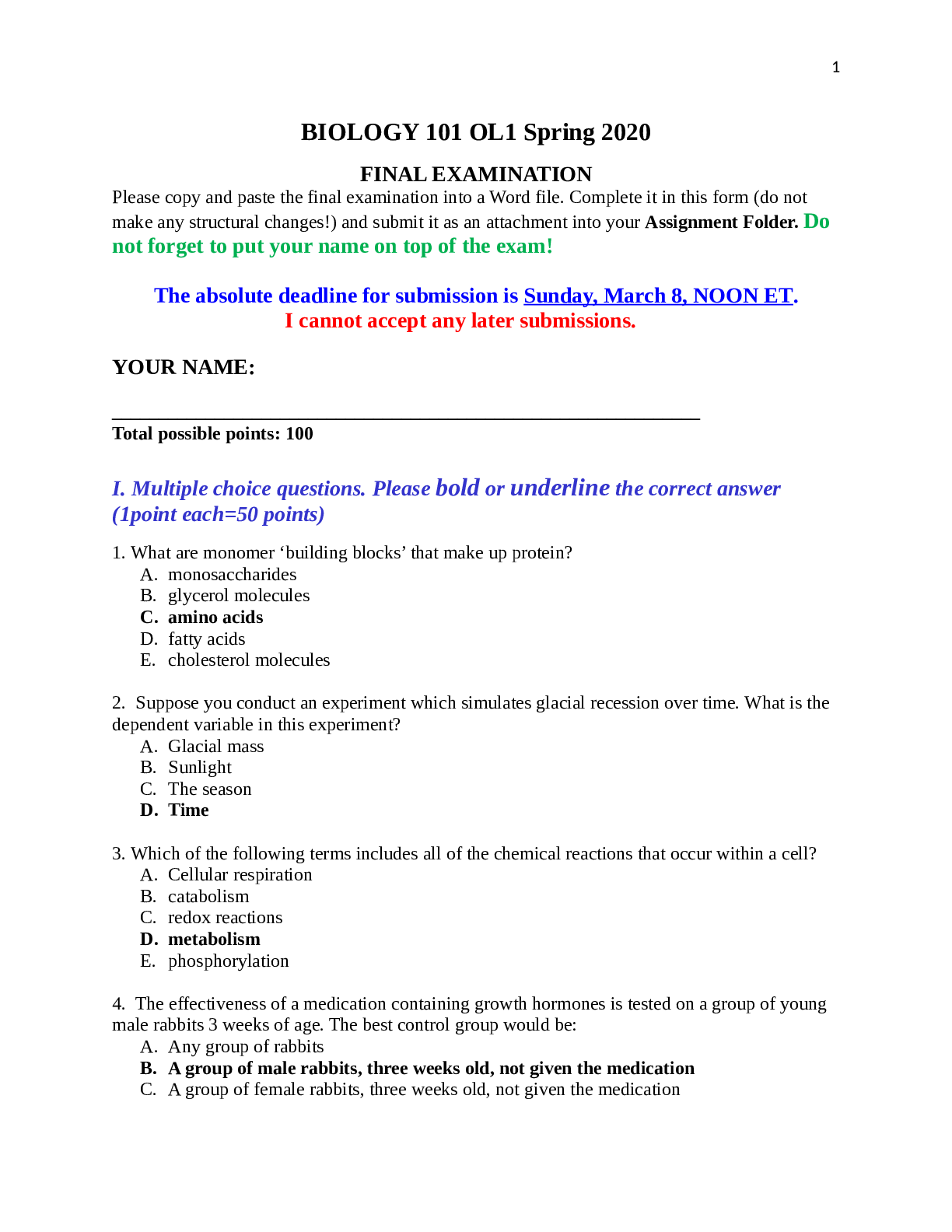
Reviews( 0 )
Document information
Connected school, study & course
About the document
Uploaded On
Aug 14, 2022
Number of pages
12
Written in
Additional information
This document has been written for:
Uploaded
Aug 14, 2022
Downloads
0
Views
22





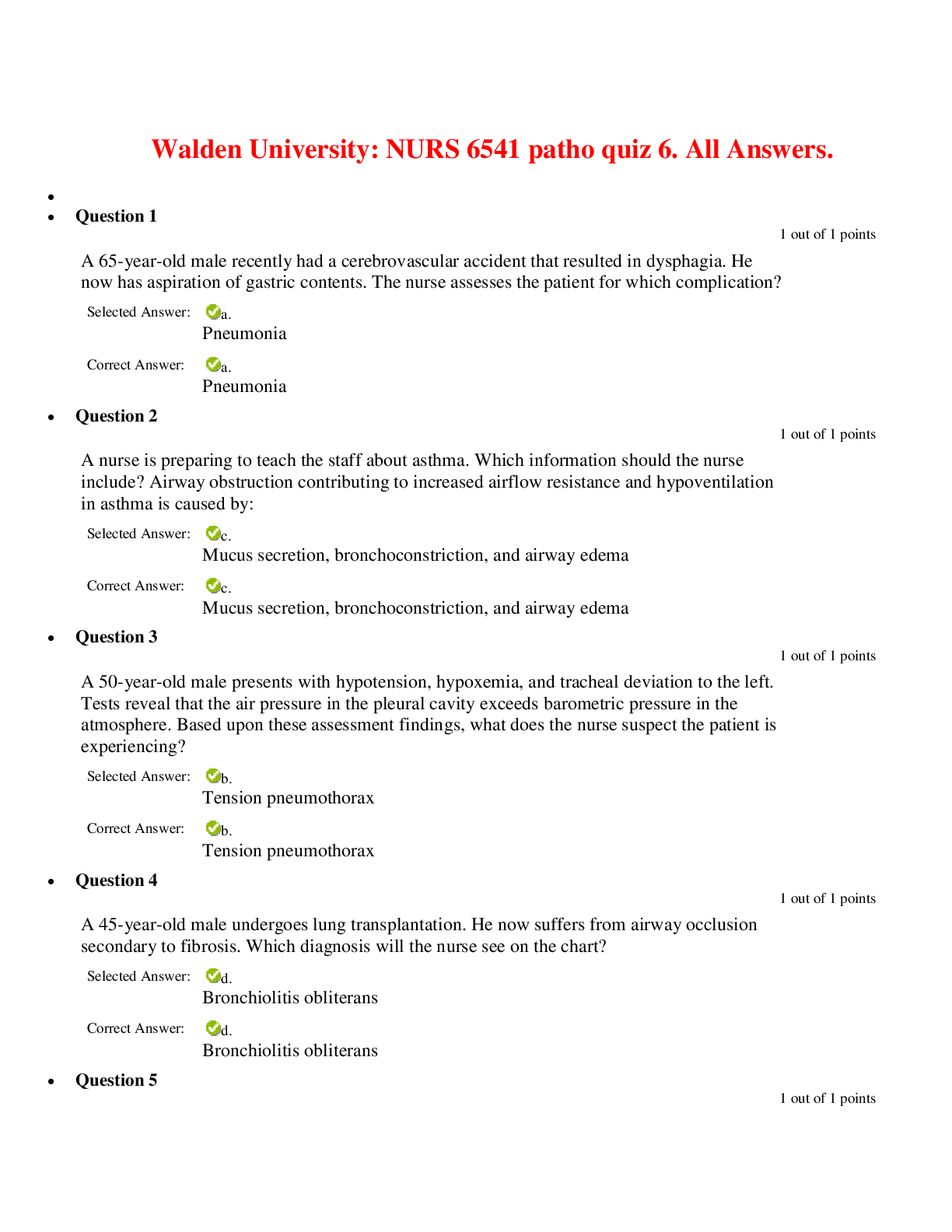





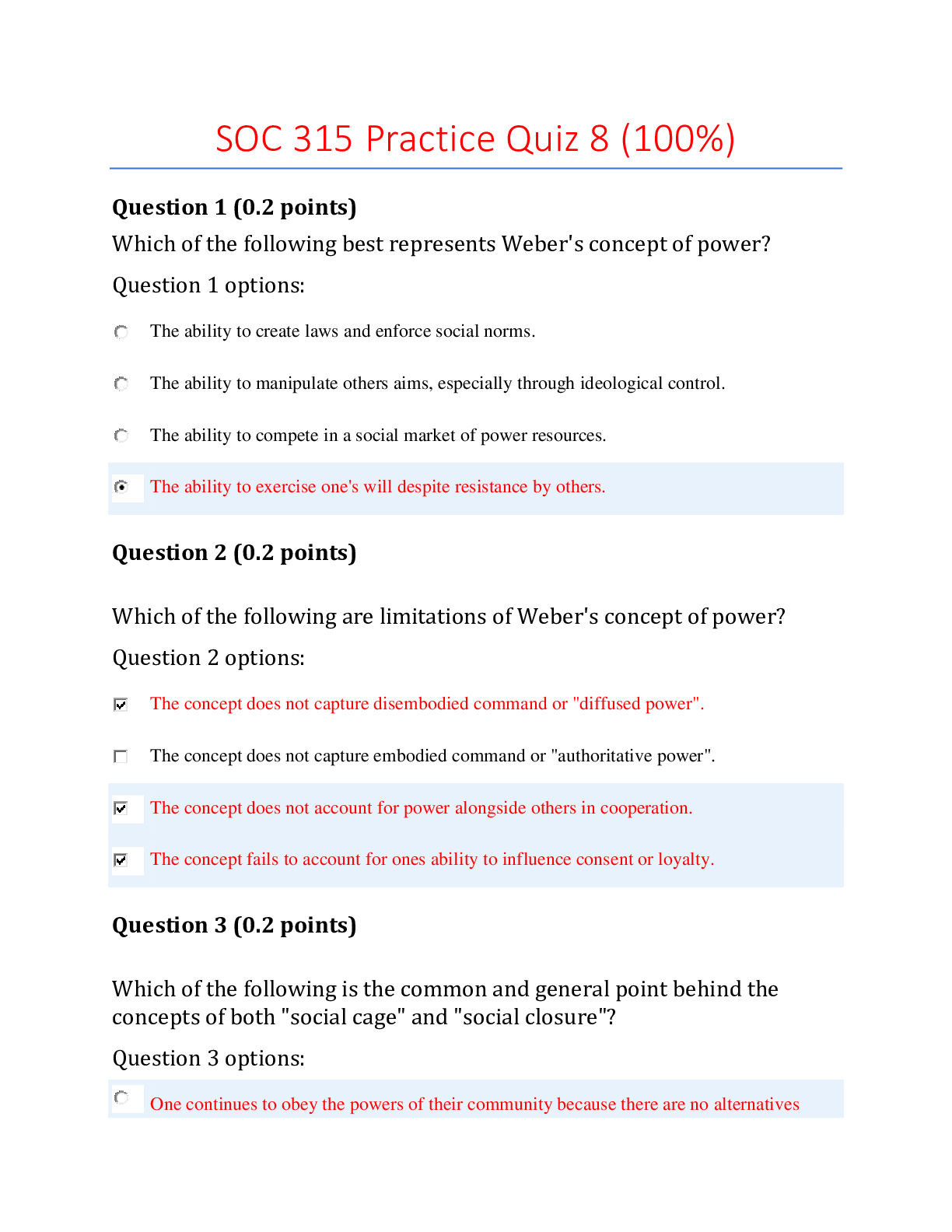
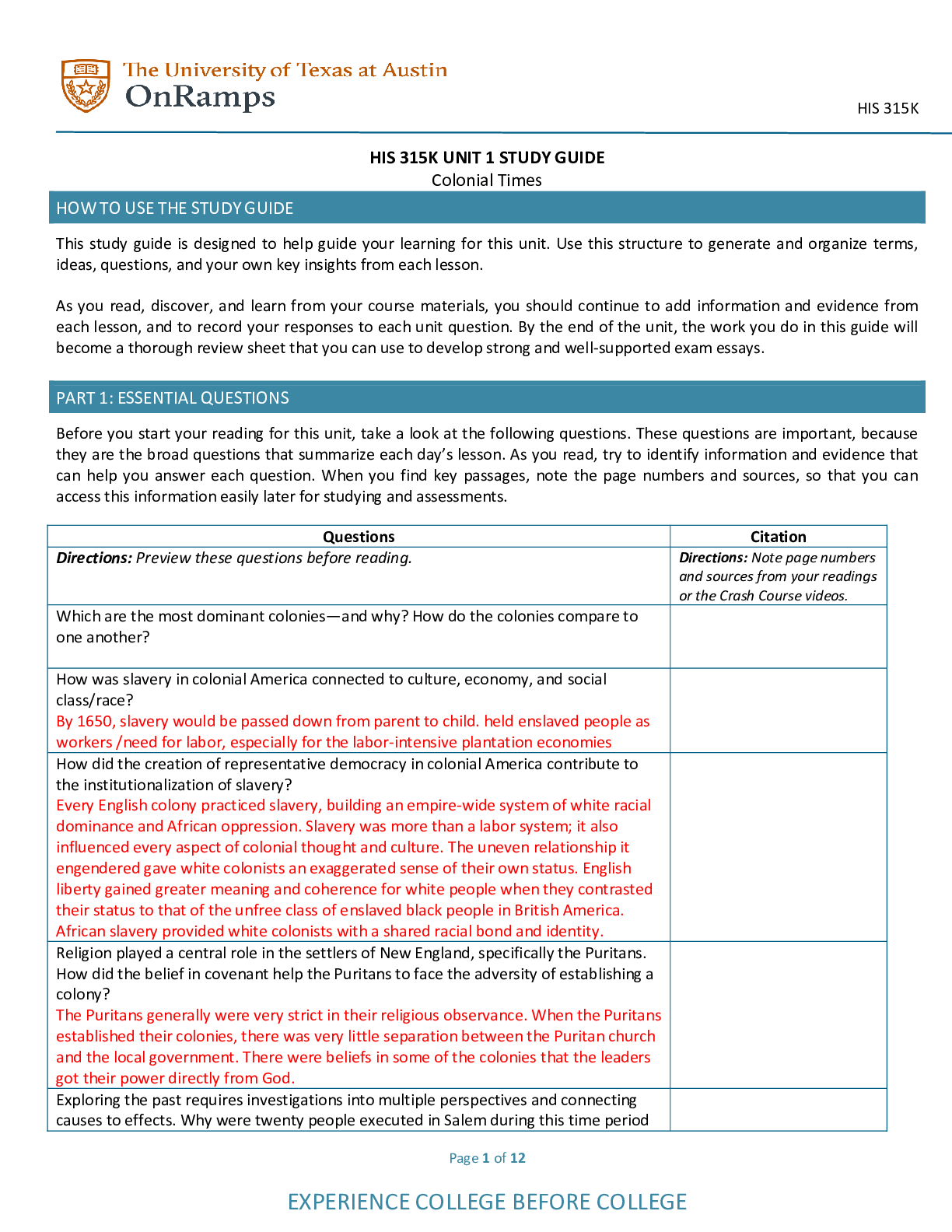
.png)

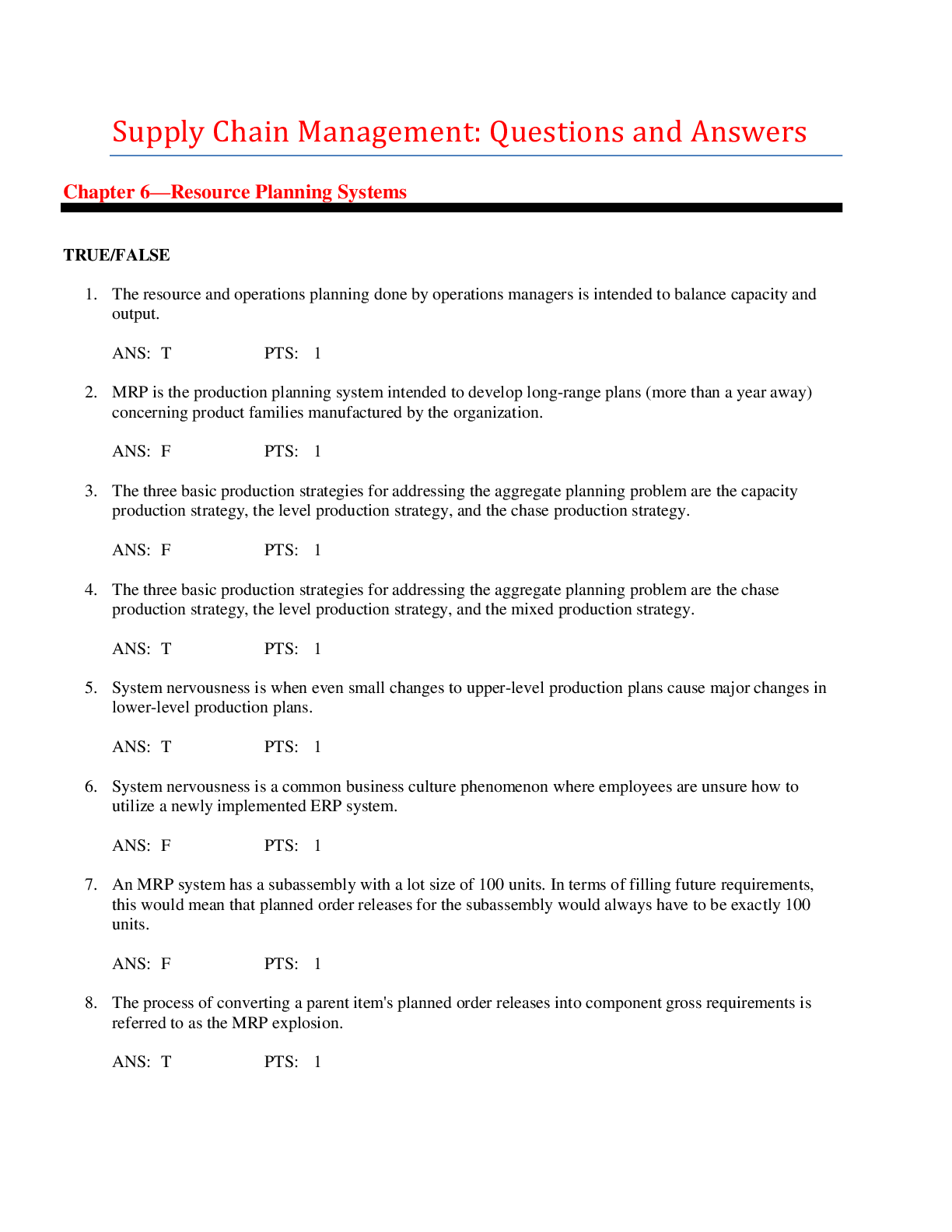
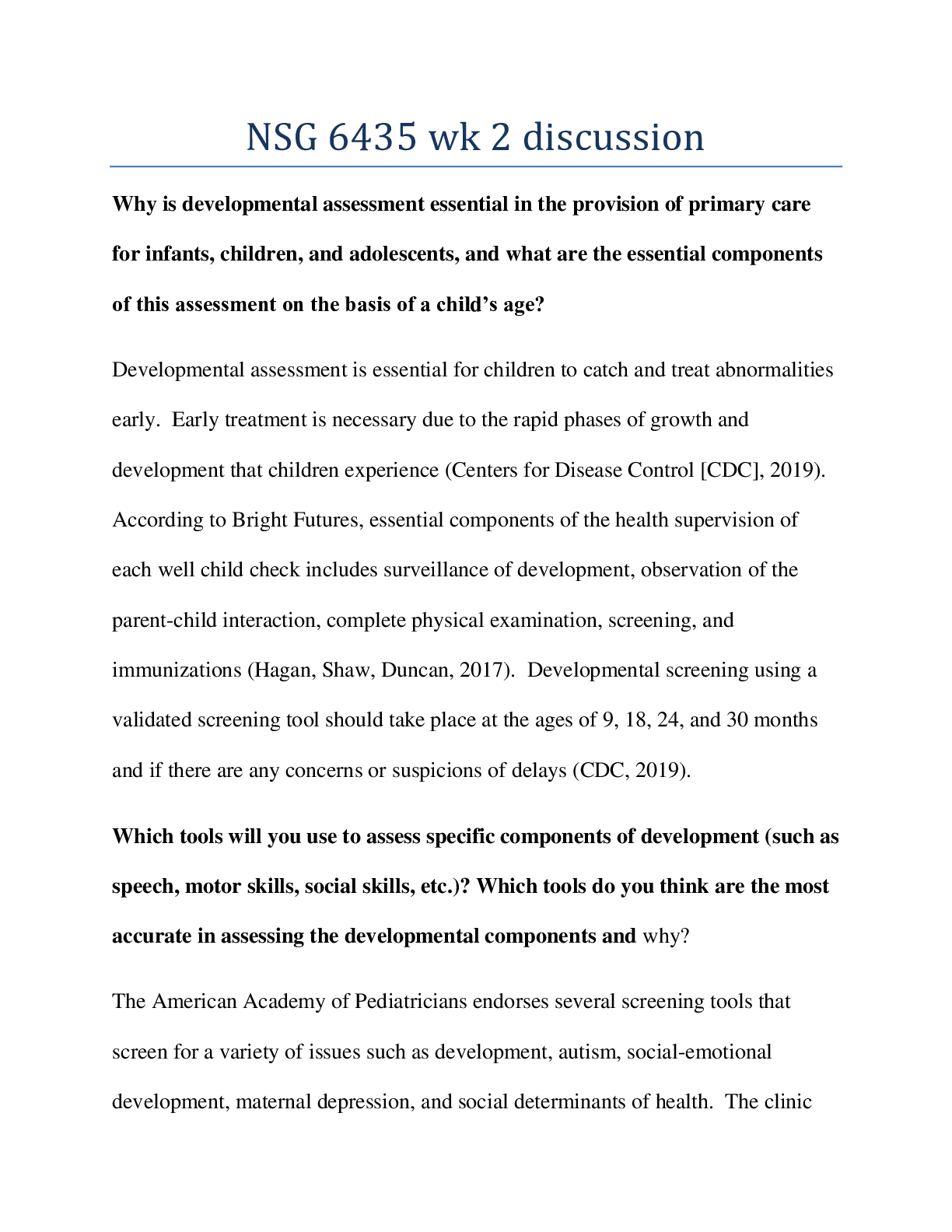
.png)

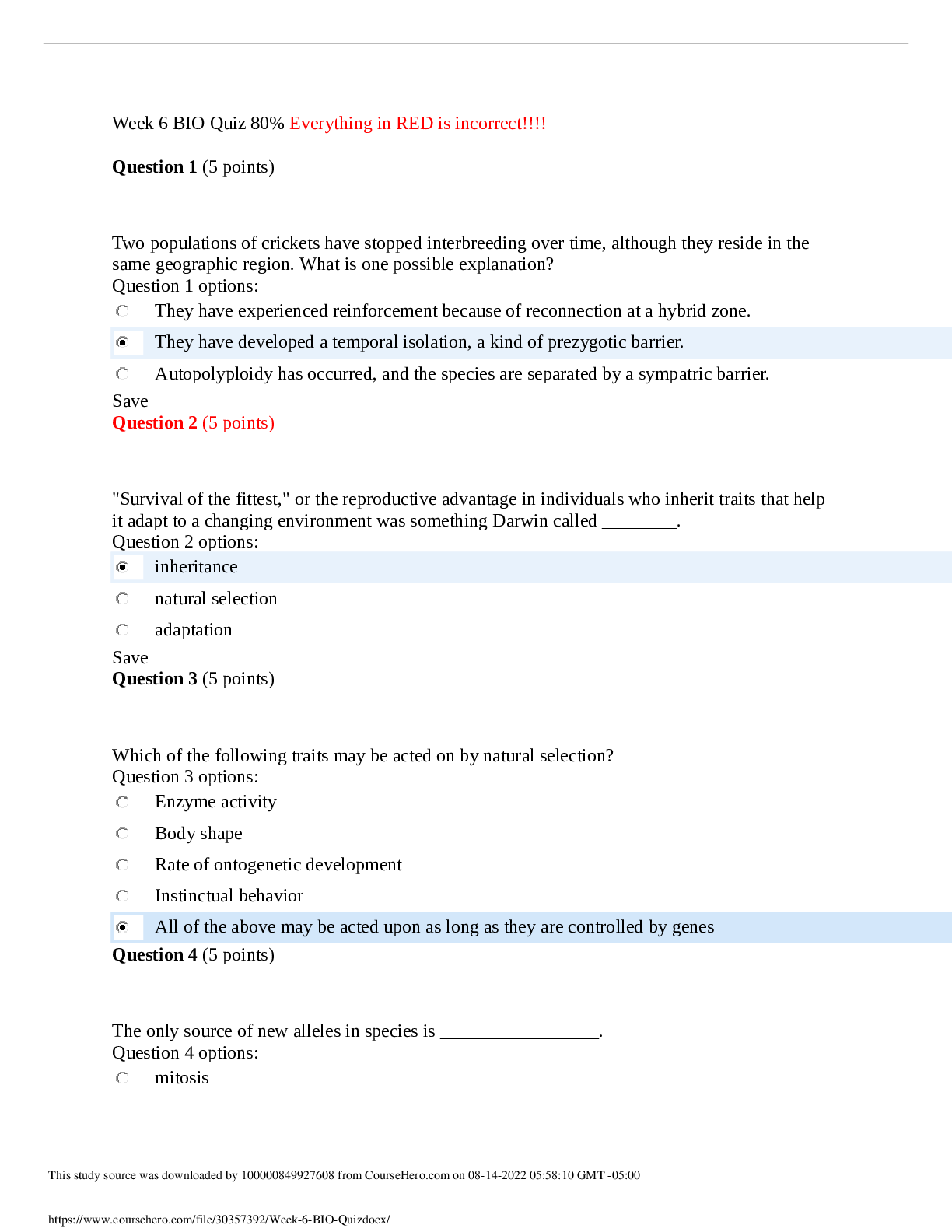

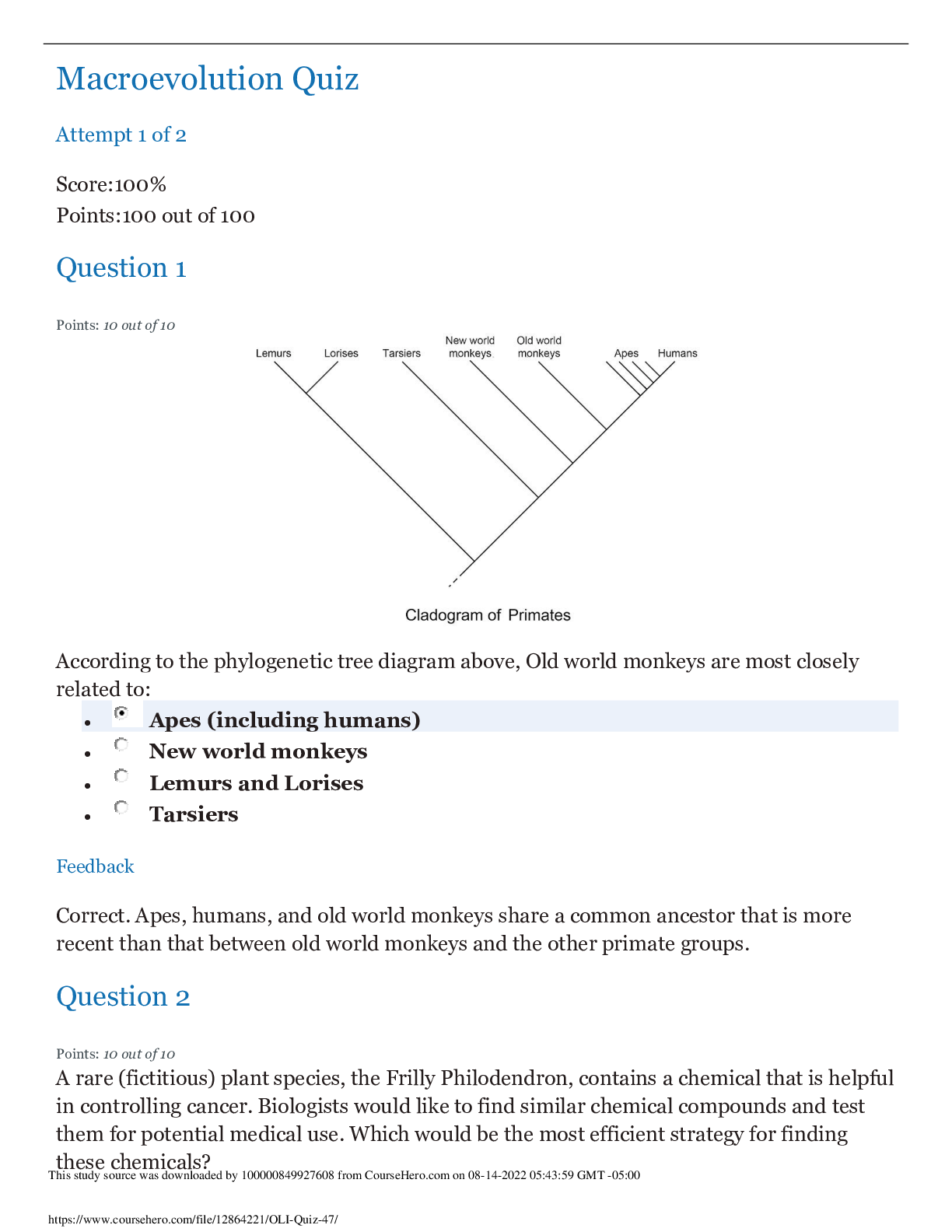
.png)
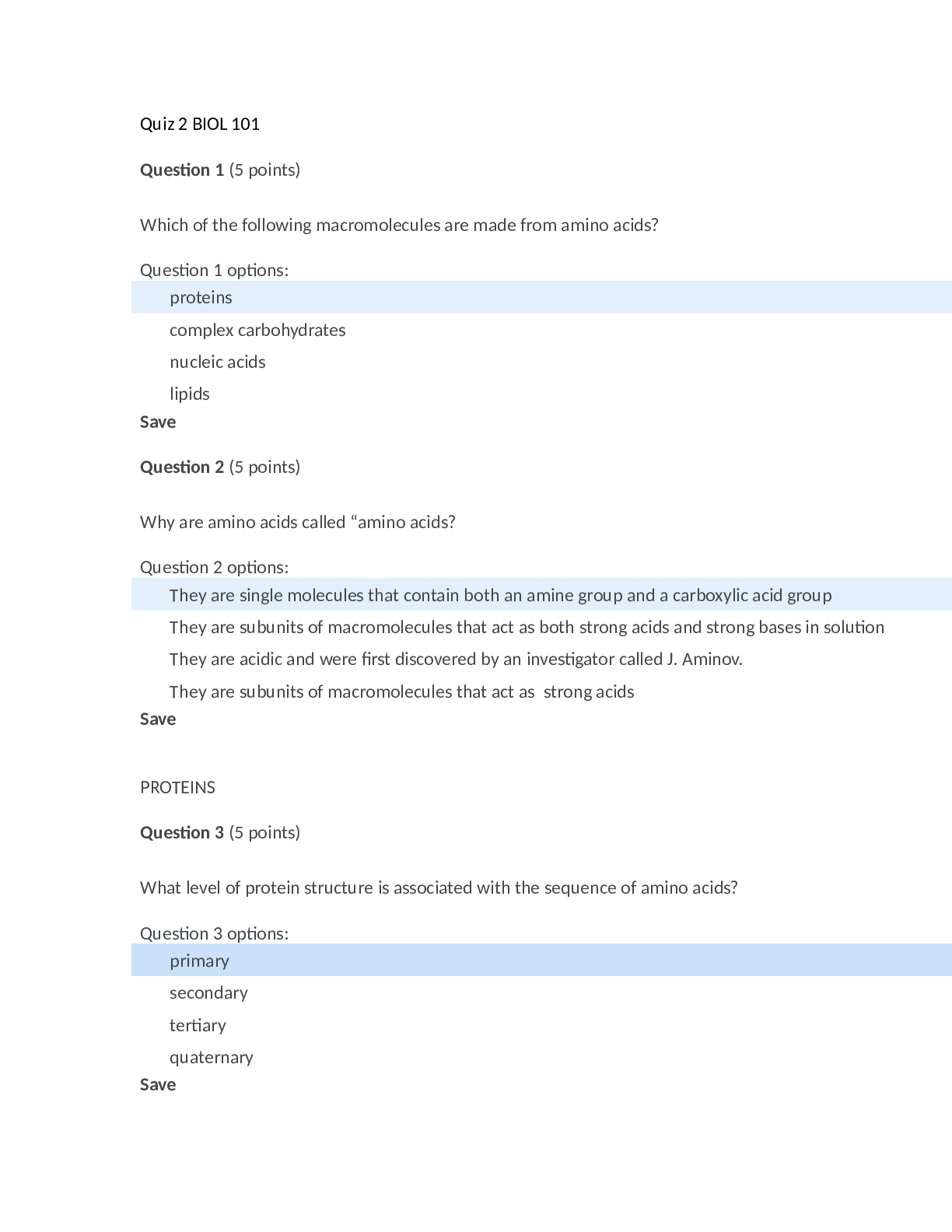
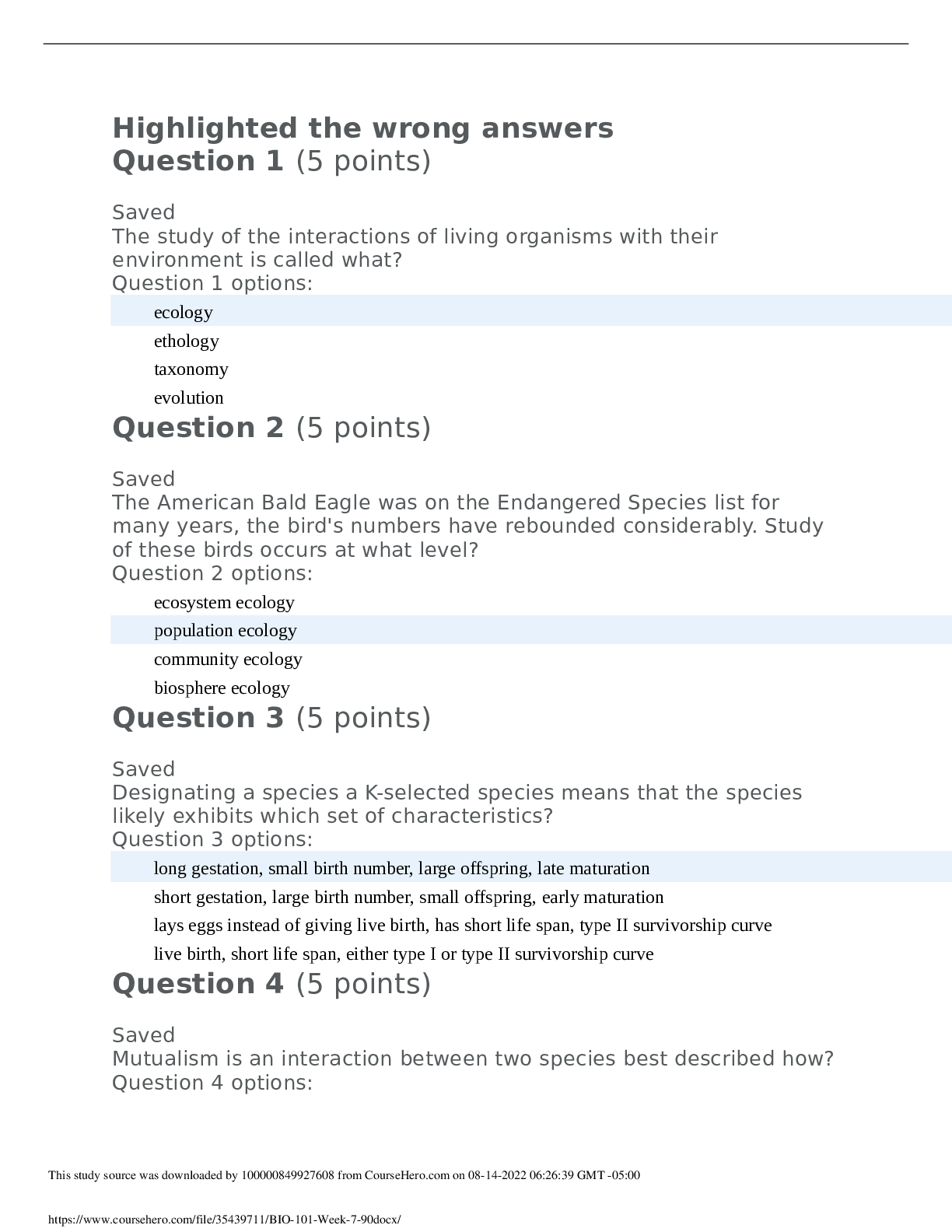

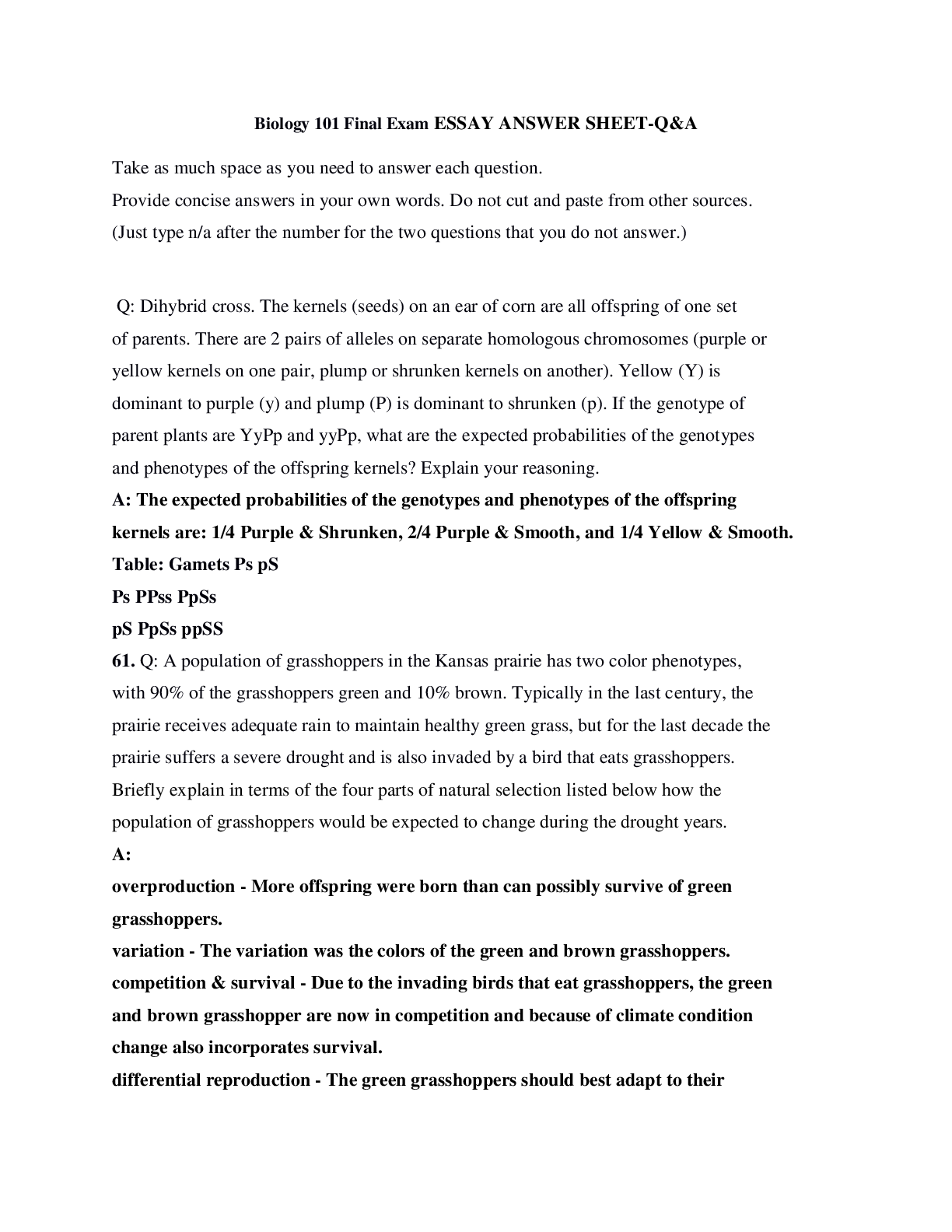
.png)
